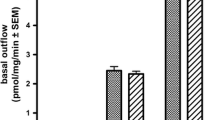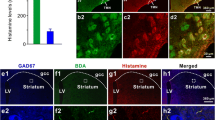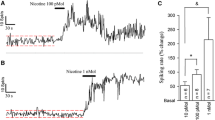Summary
It has been suggested that dopamine release can be evoked by excitatory amino acids acting on dopaminergic terminals, as well as by the classical process of impulse-evoked exocytosis. We used in vivo microdialysis to examine whether endogenous excitatory amino acids locally evoke dopamine efflux under basal conditions. Infusion of N-methyl-d-aspartate (NMDA) or kainate into the neostriatum increased extracellular dopamine, and this effect was blocked by co-infusion of 2-amino-5-phosphonovalerate (APV) or 6-cyano-7-nitroquinoxaline-2,3-dione (CNQX), respectively. However, neither these antagonists nor kynurenate decreased extracellular dopamine when administered alone. In contrast, infusion of tetrodotoxin into the medial forebrain bundle reduced extracellular dopamine to below the limit of detection of our assay. These and other findings reviewed in this report suggest to us that extracellular dopamine in the neostriatum is not stimulated locally by endogenous excitatory amino acids.
Similar content being viewed by others
References
Abercrombie ED, Zigmond MJ (1990) Striatal DA release: in vivo evidence for local initiation. In: Kalsner S, Westfall TC (eds) Presynaptic receptors and the question of autoregulation of neurotransmitter release. Ann NY Acad Sci 604: 575–578
Abercrombie ED, Keefe KA, DiFrischia DS, Zigmond MJ (1989) Differential effects of stress on in vivo dopamine release in striatum, nucleus accumbens, and medial frontal cortex. J Neurochem 52: 1655–1658
Barbeito L, Girault JA, Godeheu G, Pittaluga A, Glowinski J, Cheramy A (1989) Activation of the bilateral corticostriatal glutamatergic projection by infusion of GABA into thalamic motor nuclei in the cat: an in vivo release study. Neuroscience 28: 365–374
Barbeito L, Cheramy A, Godeheu G, Desce JM, Glowinski J (1990) Glutamate receptors of a quisqualate-kainate subtype are involved in the presynaptic regulation of dopamine release in the cat caudate nucleus in vivo. Eur J Neurosci 2: 304–311
Benveniste H, Huttemeier PC (1990) Microdialysis-theory and application. Prog Neurobiol 35: 195–215
Bouyer JJ, Park DH, Joh TH, Pickel VM (1984) Chemical and structural analysis of the relation between cortical inputs and tyrosine hydroxylase-containing terminals in rat neostriatum. Brain Res 302: 267–275
Bowyer JF, Newport GD, Lipe GW, Frame LT (1992) A further examination of the effects of K+ depolarization on glutamate-evoked [3 H] dopamine release from striatal slices. J Pharmacol Exp Ther 261: 72–80
Butcher SP, Hamberger A (1987) In vivo studies on the extracellular, and veratrine-releasable, pools of endogenous amino acids in the rat striatum: effects of corticostriatal deafferentation and kainic acid lesion. J Neurochem 48: 713–721
Carter CJ, L'Heureux R, Scatton B (1988) Differential control by N-methyl-D-aspartate and kainate of striatal dopamine release in vivo: a trans-striatal dialysis study. J Neurochem 51: 462–468
Cheramy A, Romo R, Godeheu G, Baruch P, Glowinski J (1986) In vivo presynaptic control of dopamine release in the cat caudate nucleus. II. Facilitatory or inhibitory influence of L-glutamate. Neuroscience 19: 1081–1090
Cheramy A, Barbeito L, Godeheu G, Desce JM, Pittaluga A, Galli T, Artaud F, Glowinski J (1990) Respective contributions of neuronal activity and presynaptic mechanisms in the control of the in vivo release of dopamine. J Neural Transm 29: 183–193
Chesselet M-F (1984) Presynaptic regulation of neurotransmitter release in the brain: facts and hypotheses. Neuroscience 12: 347–375
Clow DW, Jhamandas K (1989) Characterization of L-glutamate action on the release of endogenous dopamine from the rat caudate-putamen. J Pharmacol Exp Ther 248: 722–728
Divac I, Fonnum F, Storm-Mathisen J (1977) High affinity uptake of glutamate in terminals of corticostriatal axons. Nature 266: 377–378
Donzanti BA, Yamamoto BK (1988) An improved and rapid HPLC-EC method for the isocratic separation of amino acid neurotransmitters from brain tissue and microdialysis perfusates. Life Sci 43: 913–922
Dunn AJ, File SE (1983) Cold restraint alters dopamine metabolism in frontal cortex, nucleus accumbens, and neostriatum. Physiol Behav 31: 511–513
Erulkar SD (1989) Chemically mediated synaptic transmission: an overview. In: Siegel G, Agranoff B, Albers RW, Molinoff P (eds) Basic neurochemistry: molecular, cellular, and medical aspects. Raven Press, New York, pp 151–182
Fillenz M, Wheeler B, Boutelle MG (1991) Regulation of the physiological release of dopamine. In: Rollema H, Westerink B, Drifthout WJ (eds) Monitoring molecules in neuroscience. Proceedings of the Fifth International Congress on In Vivo Methods, September 21–24, 1991, Noordwijkerhaut, The Netherlands. Krips Repro, Meppel, The Netherlands, pp 315–316
Fonnum F, Storm-Mathisen J, Divac I (1981) Biochemical evidence for glutamate as neurotransmitter in corticostriatal and corticothalamic fibers in rat brain. Neuroscience 6: 863–873
Giorguieff MF, Kemel ML, Glowinski J (1977) Presynaptic effect of L-glutamic acid on the release of dopamine in rat striatal slices. Neurosci Lett 6: 73–77
Girault JA, Spampinato U, Desban M, Glowinski J, Besson MJ (1986) Enhancement of glutamate release in the rat striatum following electrical stimulation of the nigrothalamic pathway. Brain Res 374: 362–366
Globus MT, Busto R, Dietrich WD, Martinez E, Valdes I, Ginsberg MD (1988) Effect of ischemia on the in vivo release of striatal dopamine, glutamate, and γ-amino butyric acid studied by intracerebral microdialysis. J Neurochem 51: 1455–1464
Hanbauer I, Wink D, Osawa Y, Edelman GM, Galley JA (1992) Role of nitric acid oxidation in NMDA-evoked release of [3 H]-dopamine from striatal slices. Neuroreports 3: 409–412
Hurd YL, Ungerstedt U (1989) Influence of a carrier transport process on in vivo release and metabolism of DA: dependence on extracellular NA+. Life Sci 45: 283–293
Imperato A, Di Chiara G (1988) Effects of locally applied D-1 and D-2 receptor agonists and antagonists studied with brain dialysis. Eur J Pharmacol 156: 385–393
Imperato A, Scrocco MG, Bacchi S, Angelucci L (1990) NMDA receptors and in vivo dopamine release in the nucleus accumbens and caudatus. Eur J Pharmacol 187: 555–556
Jhamandas K, Marien M (1987) Glutamate-evoked release of endogenous brain dopamine: inhibition by an excitatory amino acid antagonist and an enkephalin analogue. Br J Pharmacol 90: 641–650
Kapatos G, Zigmond MJ (1977) Dopamine biosynthesis from L-tyrosine and L-phenylalanine in rat brain synaptosomes: preferential use of newly accumulated precursors. J Neurochem 28: 1109–1119
Keefe KA, Stricker EM, Zigmond MJ, Abercrombie ED (1990) Environmental stress increases extracellular dopamine in striatum of 6-hydroxydopamine-treated rats: in vivo microdialysis studies. Brain Res 527: 350–353
Keefe KA, Sved AF, Zigmond MJ, Abercrombie ED (1992 a) Stress-induced dopamine release in striatum: excitatory amino stimulated or action potential dependent? Soc Neurosci Abstr 18: 95
Keefe KA, Zigmond MJ, Abercrombie ED (1992 b) Extracellular dopamine in striatum: influence of nerve impulse activity in medial forebrain bundle and local glutamatergic input. Neuroscience 47: 325–332
Kim J-S, Hassler R, Haug P, Paik K-S (1977) Effect of frontal cortex ablation on striatal glutamic acid level in rat. Brain Res 132: 370–374
Langer SZ, Moret C (1988) Presynaptic receptors on catecholamine neurones. In: Trendelenburg U, Weiner N (eds) Handbook of experimental pharmacology. Catecholamines I. Springer, Berlin Heidelberg New York Tokyo, pp 419–507
Leviel V, Gobert A, Guibert B (1990) The glutamate-mediated release of dopamine in the rat striatum: further characterization of the dual excitatory-inhibitory function. Neuroscience 39: 305–312
Lonart G, Zigmond M (1991) High glutamate concentrations evoke Ca++-independent dopamine release from striatal slices: a possible role of reverse dopamine transport. J Pharmacol Exp Ther 256: 1132–1138
Marien M, Brien J, Jhamandas K (1983) Regional release of [3 H]dopamine from rat brain in vitro: effects of opioids on release induced by potassium, nicotine, and L-glutamic acid. Can J Physiol Pharmacol 61: 43–60
McGeer PL, McGeer EG, Scherer U, Singh K (1977) A glutamatergic corticostriatal path? Brain Res 128: 369–373
Moghaddam B, Gruen RJ (1991) Do endogenous excitatory amino acids influence striatal dopamine release? Brain Res 544: 329–330
Moghaddam B, Gruen RJ, Roth RH, Bunney BS, Adams RN (1990) Effect of L-glutamate on the release of striatal dopamine: in vivo dialysis and electrochemical studies. Brain Res 518: 55–60
Morre MC, Wurtman RJ (1981) Characteristics of synaptosomal tyrosine uptake in various brain regions: effect of other amino acids. Life Sci 28: 65–75
Pei Q, Zetterstrom T, Fillenz M (1990) Tail pinch-induced changes in the turnover and release of dopamine and 5-hydroxytryptamine in different brain regions of the rat. Neuroscience 35: 133–138
Raiteri M, Marchi M, Maura G (1984) Release of catecholamines, serotonin, and acetylcholine from isolated brain tissue. In: Lajtha A (ed) Handbook of neurochemistry, vol 6. Plenum Press, New York, pp 431–462
Rao TS, Cler JA, Mick SJ, Emmett MR, Farah JM Jr, Contreras PC, Iyengar S, Wood PL (1991) Neurochemical interactions of competitive N-methyl-D-aspartate antagonists with dopaminergic neurotransmission and the cerebellar cyclic GMP system: functional evidence for a phasic glutamatergic control of the nigrostriatal dopaminergic pathway. J Neurochem 56: 907–913
Roberts PJ, Sharif NA (1978) Effects of L-glutamate and related amino acids upon the release of [3 H]dopamine from rat striatal slices. Brain Res 157: 391–395
Roberts PJ, Anderson SD (1979) Stimulatory effect of L-glutamate and related amino acids on [3 H]dopamine release from rat striatum: an in vitro model for glutamate actions. J Neurochem 32: 1539–1545
Romo R, Cheramy A, Godeheu G, Glowinski J (1986 a) In vivo presynaptic control of dopamine release in the cat caudate nucleus. I. Opposite changes in neuronal activity and release evoked from thalamic motor nuclei. Neuroscience 19: 1067–1079
Romo R, Cheramy A, Godeheu G, Glowinski J (1986 b) In vivo presynaptic control of dopamine release in the cat caudate nucleus. III. Further evidence for the implication of corticostriatal glutamatergic neurons. Neuroscience 19: 1091–1099
Rudolph MI, Bustos G (1986) Functional and biochemical characteristics of a putative quisqualate-type receptor in rat striatum: effects of brain lesions. Neurochem Res 11: 1533–1545
Rudolph MI, Arqueros L, Bustos G (1983) L-glutamic acid, a neuromodulator of dopaminergic transmission in the rat corpus striatum. Neurochem Int 5: 479–486
Schultz W, Romo R (1987) Responses of nigrostriatal dopamine neurons to high-intensity somatosensory stimulation in the anesthetized monkey. J Neurophysiol 57: 210–217
Shimizu N, Duan S, Hori T, Oomura Y (1990) Glutamate modulates dopamine release in the striatum as measured by brain microdialysis. Brain Res Bull 25: 99–102
Starke K, Gothert M, Kilbinger H (1989) Modulation of neurotransmitter release by presynaptic autoreceptors. Physiol Rev 69: 864–988
Strecker RE, Jacobs BL (1985) Substantia nigra dopaminergic activity in behaving cats: effect of arousal on spontaneous discharge and sensory evoked activity. Brain Res 361: 339–350
Vizi ES (1984) Non-synaptic interactions between neurons: modulation of neurochemical transmission. Wiley, Chichester
Werling LL, Jacocks III HM, McMahon PN (1990) Regulation of [3 H]dopamine release from guinea pig striatum by NMDA receptor/channel activators and inhibitors. J Pharmacol Exp Ther 255: 40–45
Westerink BHC, de Vries JB (1989) On the mechanism of neuroleptic induced increase in striatal dopamine release: brain dialysis provides direct evidence for mediation by autoreceptors localized on nerve terminals. Neurosci Lett 99: 197–202
Westerink BHC, Hofsteede RM, Tuntler J, De Vries JB (1989) Use of calcium antagonism for the characterization of drug-evoked dopamine release from the brain of conscious rats determined by microdialysis. J Neurochem 52: 722–729
Westfall TC (1990) The physiological operation of presynaptic inhibitory autoreceptors. In: Kalsner S, Westfall TC (eds) Presynaptic receptors and the question of autoregulation of neurotransmitter release. Ann NY Acad Sci 604: 398–413
Young AMJ, Bradford HF (1986) Excitatory amino acid neurotransmitters in the corticostriate pathway: studies using intracerebral microdialysis in vivo. J Neurochem 47: 1399–1404
Young AMJ, Bradford HF (1991) N-methyl-D-aspartate releases excitatory amino acids in rat corpus striatum in vivo. J Neurochem 56: 1677–1683
Zetterstrom T, Sharp T, Collin AK, Ungerstedt U (1988) In vivo measurement of extra-cellular dopamine and DOPAC in rat striatum after various dopamine-releasing drugs: implications for the origin of extracellular DOPAC. Eur J Pharmacol 148: 327–334
Author information
Authors and Affiliations
Rights and permissions
About this article
Cite this article
Keefe, K.A., Zigmond, M.J. & Abercrombie, E.D. In vivo regulation of extracellular dopamine in the neostriatum: influence of impulse activity and local excitatory amino acids. J. Neural Transmission 91, 223–240 (1993). https://doi.org/10.1007/BF01245233
Received:
Accepted:
Issue Date:
DOI: https://doi.org/10.1007/BF01245233




